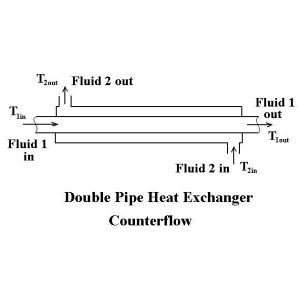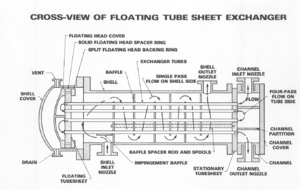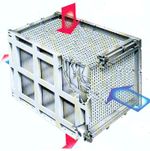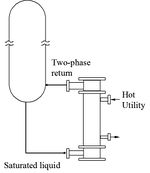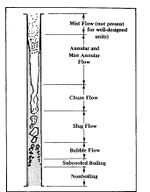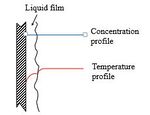Heat Transfer Equipment
Authors: David Chen [2014] and Matthew Leung [2015]
Stewards: David Chen, Jian Gong, Fengqi You
Date Presented: January 13, 2014 /Date Revised: January 14, 2014
Basic Concept
There are three mechanisms of heat transfer: conduction, convection, and radiation. In most heat exchangers, convection will be the dominant mechanism. Conduction and radiation will generally be negligible in large heat exchangers, but radiation will be important in fired heaters.
Heat transfer across a surface by convection is given by the equation:
Where: = heat transferred per unit time (energy/time)
= overall heat-transfer coefficient (energy/time-area-temperature)
= heat-exchange area (area)
= correction factor (unitless)
= log mean temperature difference or the temperature driving force, (temperature)
is the driving force for a pure countercurrent contact pattern in a tubular system. the correction factor is used because most heat exchangers do not implement true countercurrent contact. Design equations for heat exchangers will use generally use some form of this equation with the appropriate modifications to account for different configurations and approximations. (Towler)
Heat Exchangers
Process equipment and streams will need to be heated or cooled. One way to reduce consumption of utilities is to exchange heat between these streams. For example, if a product stream requires cooling, the excess heat can be used to preheat a feed stream that requires heating by using an appropriate heat exchanger. Here the costs of an additional heating and additional cooling unit are eliminated, and replaced by the cost of a heat exchanger. The associated utility requirements of the additional units are also eliminated and replaced by the utility requirements of operating the heat exchanger.
Traditionally shell-and-tube heat exchangers in chemical industry. Standards and codes by TEMA (Tubular Exchanger Manufacturers Association) and ASME (American Society of Mechanical Engineers)
Factors to Consider
The heat exchanger must meet certain physical requirements both to carry out the specified heat exchange and operate properly as part of a system. As such, it must provide the correct area for the specified heat exchange while maintaining a reasonable pressure drop, contain the pressure of the streams, prevent leaks between the tubes and the shell, account or thermal expansion, allow for cleaning of fouling deposits, allow for thermal expansion, and phase changes in certain applications.
It should be noted that heat exchangers rarely operate at the exact conditions specified for design. Because performance will decrease with fouling, a heat exchanger may be initially overdesigned, and after some amount of fouling, underdesigned, at which point cleaning should take place. Depending on the performance of a heat exchanger at any given time, downstream processes may be affected.
Thermal and hydraulic requirements
A certain amount of energy needs to be exchanged, and the pressure drop across the heat exchanger must be accounted for in the context of the process. It may be acceptable, or may need to be maintained using pumps. The key tradeoff in heat exchangers is the heat exchanged vs. pressure drop. More surface area can always be added, but the pressure drop may become unacceptable for downstream processes.
Material compatibility
Heat exchangers must be able to maintain acceptable performance through prolonged contact in the materials with which heat is being exchanged. While regular maintenance and cleaning is unavoidable, appropriate construction materials should be chosen that are not prone to excessive corrosion or fouling.
Operational Maintenance
Fouling on the heat transfer surface will reduce the overall heat transfer coefficient and efficiency. To maintain economical operation, the fouling will need to be periodically removed. Depending on the type of heat exchanger used, it may be disassembled and cleaned, or it will have to remain intact and be cleaned chemically, which can involve hazardous materials.
Environmental, health, and safety considerations and regulations
Hazards and toxicity of the streams involved must be guarded against, and safety codes must be met. Plans must be prepared to deal with leaks or failures of the heat exchanger that will minimize adverse effects.
Availability and cost
A with any project, the ability of the heat exchanger construction to fall within the deadlines and costs is key to the economics. (Peters)
Types of Heat Exchangers
Double Pipe
The simplest heat exchanger. It is essentially a “tube-within a tube.” Only used when heat transfer requirement is small, or both fluid streams are of high pressure. One way to improve heat transfer is to add fins on the outside of the inner tube. This is used to improve the heat transfer of a fluid with a low heat transfer coefficient such as a viscous liquid or a gas, which is passed on the outer side. A more common configuration of the double pipe is with modular U-tubes in a “hairpin” configuration to conserve space. (Peters)
Shell-and-Tube
A bundle of tubes is passed through a shell. Heat exchange occurs between the fluid inside the tubes (tube-side) and the fluid outside of the tubes but within the shell (shell-side). Baffles are often used to direct the flow of the shell-side fluids as well as to support the tube bundle. TEMA has set standards for construction of shell-and-tube heat exchangers as well as nomenclature for the front heads (4 types), shells (6 types), and rear heads (8 types). (Towler/UOP)
Three commonly used types of shell-and-tube heat exchangers are: the fixed-tube, U-tube, and floating-head type. Each has its own set of advantages and disadvantages. For example, the fixed-tube type exchanger has the simplest construction, which reduces construction cost and difficulty of routine cleaning. However, it may not be the most efficient. Meanwhile, the U-tube configuration allows more surface area inside the exchanger, but is more difficult to clean. Additionally, the flow pattern is not truly a counterflow pattern unless a longitudinal baffle is used (Type F shell). The U-tube configuration is more able to absorb the stress of thermal expansion than the fixed tube exchanger. Finally, the floating¬-head exchanger can move within the shell, which allows the exchanger to handle higher temperatures and pressures. However, it is more complex than the former two types, and thus construction can be approximately 25 percent higher for a unit of similar area.(Peters)
The tube pitch describes the center-to-center distance for the arrangement of the tube bundle, and can be square or triangular. A larger pitch leaves more space between tubes and allows for easier cleaning, but this comes at the cost of a lower shell-side heat transfer coefficient and the need for a larger shell. A smaller pitch allows more tubes to be fit inside a given shell.
Triangular pitch allows for tighter packing of tubes in a shell. If shell-side fouling is a problem, square pitch should be used for easier cleaning. In horizontal boiling heat exchangers, square pitch should also be used to prevent vapor blanketing. Square pitch should also be used when there is a lower shell-side pressure drop. (Towler/UOP)
The baffles lead to increased pressure drop of the shell-side fluid. However, it also improves the mixing of the fluid and increases turbulence, which leads to improved heat transfer. Again, the tradeoff between improved heat transfer and pressures drop is illustrated. The most common type of baffle is the segmental baffle. Other baffles include the disk-and-doughnut, orifice, no-tube-in-window, and triple segmental baffle.
Scraped-Surface
Crystallization systems and heat transfer involving viscous fluids, fouling may occur rapidly enough to make routine cleaning impractical. In this case, a rotating blade moves over the surface, liberating the deposited material from the surface and allowing it to exit at the bottom of the exchanger. Additionally, the motion of the blade shears the deposited product close to the wall, which results in high local heat transfer rates. Scraped-surface exchangers are generally not considered unless liquid viscosity exceeds 1 Pa•s or fouling is rapid.
Gasketed and Welded Plate
Plate heat exchangers consist of a stack of corrugated plates. The corrugation of the plates improves rigidity, controls spacing of the plates, and increases the heat-transfer area compared to a flat plate.The hot and cold streams flow countercurrently through the alternating spaces created by the plates. The modular design allows easy addition of more heat transfer area, but at a cost of increased pressure drop. Edges can be sealed with gaskets for lower pressures. Cleaning is relatively simple because the configuration can be disassembled and cleaned. For operating at higher pressures the edges can be welded. Welded-plate heat exchangers typically do not operate past 3 MPa. However, in welding the plates together, the convenience of disassembling and cleaning the modular plates is lost, and cleaning must be done chemically. Additionally, the plates are usually larger than those of the gasketed-plate exchanger to reduce the amount of welding necessary.
Spiral Plate and Tube
Spiral plates are coiled to create alternating passages for the fluids. The cold fluid enters at the periphery and flows towards the center, while the hot fluid enters at the center and flows outward. Introducing the cold fluid at the periphery reduces or eliminates the need for external insulation. These heat exchangers are used for small capacities with viscous, fouling, and corrosive fluids. The end plates can be removed for cleaning the shell. However, the configuration of the tube makes the spiral plates difficult to clean.
Plate-Fin
Plate-fin heat exchangers consist of layers of corrugated metallic sheets (fins) between flat plates to form the flow passages. The plates are sealed with metal bars on the side. Plate-fin heat exchangers can be 9 times as compact as a shell-and-tube heat exchanger, and weighs less. Can withstand design pressures up to 6 MPa in the temperature range of -270 and 800 ⁰C. Many different configurations of plate-fin exchangers can be used.
Gas-to-Gas
Gas-to-gas heat exchangers are primarily used to recover energy from combustion gases to preheat furnace air. The plain tube gas-to-gas heat exchanger is a simple countercurrent exchange through a tube bank, either in a single-pass (cross-flow) or multipass configuration. (Peters)
Boiling and Condensing Heat Transfer
Heat transfer involving boiling liquids or condensing vapor is different from heat transfer involving constant fluid phases. Heat transfer operations that involve phase changes are typically carried out in separate units in order to account for the different physical properties of the phases.
Boiling Heat Transfer
Boilers transfer heat to boil liquids.
Boiling Heat Transfer Coefficient
Boiling liquids have different heat transfer regimes. I: Heat transfer with natural convection II: Heat transfer with bubbling agitation III: Heat transfer with nucleate boiling with unstable film IV: Heat transfer with stable film boiling V: Radiant Heat Transfer
The heat transfer coefficient of a boiling liquid begins to decrease with the onset of film boiling. One method of improving the overall heat transfer coefficient is to use high-flux tubing, which utilizes a porous coating inside of tubes. It can improve boiling performance up to 10 times over a bare tube, and overall performance 2 to 5 times over a bare tube.
Kettle Reboilers
Kettle reboilers are often used as a steam generator. Pool boiling is used in kettle reboilers. In pool boiling, agitation occurs through bubbling and natural convection. The vapor-liquid separator is built-in and allows for blowdown. The weir helps to maintain the liquid level above the tube bundle. It also helps to prevent the entering bubble point liquid (distillation bottoms) from mixing with the residual reboiled liquid (exiting from the bottom). Kettle reboilers are more expensive than horizontal thermosiphons fabricated for a comparable duty.
Thermosiphon Reboilers
Thermosiphon reboilers use flow boiling. In flow boiling, agitation occurs through bubbling and forced convection at high velocities. They can be located at a height below the column sump. This allows the static head of the sump to force the column bottoms into the reboiler, which is designed for about 25 to 33% vaporization per pass. Thermosiphon reboilers can be vertical (tube-side) or horizontal (shell-side flow). Horizontal thermosiphon reboilers tend to be cheaper than vertical thermosiphons, but vertical thermosiphons are better at handling dirty fluids.
Flow is critical in a thermosiphon reboiler, and the different flow regimes will impact operation. The different flow regimes are caused by the increasing vapor/liquid ratio as the fluid passes through the thermosiphon.
Flow regimes in order of increasing vapor/liquid ratio: nonboiling < subcooled boiling < bubble flow < slug flow < churn flow < annular and mist flow < mist flow
Slug flow is unavoidable, but should be minimized. It causes noise and vibration in the thermosiphon. Annular and mist flow are also undesirable. Annular flow can be avoided by designing for less than 33% vaporization, and mist flow can be altogether avoided in well-designed reboilers.
Stab-in Reboilers
Stab-in reboilers are essentially the heat exchange tube bundle fitted inside a sump. In this case, the sump behaves in a similar capacity to a kettle reboiler, and mechanism of pooling is again pool boiling. It is important that there is enough space in the sump for good level control and to contain the entire tube bundle.
Condensing Heat Transfer
Condensing heat transfer is important because many heat transfer applications will condense the steam used as the hot stream, and often gaseous products are needed in liquid form. There are two types of condenser: total condensers and partial condensers. Both total and partial condensers need to account for the accumulation of noncondensable vapor. This can be done by venting through the top of the exchanger. The tube bundle arrangement affects overall heat transfer as well. Falling condensate from higher to lower tubes increases local turbulence and thus the heat transfer coefficient. However, condensate that collects on a tube and has yet to drain prevents the cooled heat transfer surface from contacting the vapor.
Total Condenser
In a total condenser, all the vapor that enters is condensed as a film on the heat transfer surface. The heat transfer coefficient is determined only by the thermal resistances.
Partial Condenser
In a partial condenser, not all of the vapor that enters is condensed. This allows for vapor-liquid separation. However, there will be a a vapor film with a higher concentration of high-boiling products. The heat transfer coefficient is not determined solely by the thermal resistance, but also in part by the mass transfer resistance as well. The condensable component of vapor will have to diffuse through the noncondensable component. The resistance to diffusion leads to a much lower overall heat transfer coefficient. Additionally, it complicates the calculation of heat transfer.
Heaters and Coolers
It is not always possible to couple process streams for heat-exchange. It is likely that separate heaters and coolers will have to be used in addition to a heat-exchange network for a process.
Heaters
Operating temperatures can be classified into three ranges: low (< 120C), medium (120-250C), and high (>250C). low temperature-range heaters generally tend to use condensate or steam, medium temperature-range heater tend to steam, and high temperature-range heaters tend to use fired heaters or hot oil loops (<400C)
Temperature and required heat load are important factors in selecting a heater.
Fired Heaters
Fired heaters are used for heating up to high temperatures. They are able to reach these high temperatures because they generate energy by combustion of natural gas, fuel oil, or process off-gas. Fox example, they are used to generate heat for hot oil loops or steam generators (boilers). Hot oil can be used up to 600F (35C), and fired heaters provide a way to reach those temperatures. High pressure steam, used for utilities, is approximately 480F (250C).
Because fired heaters carry out combustion, factors such as pollutant emissions and excess air feed need to be accounted for in addition to the required heat duty. Reducing emissions can incur substantial additional costs.
Common types of fired heaters include cabin heaters, U-tube heaters, and vertical cylindrical heaters.
Electric Heaters
In electric heaters, heat is generated by running electricity through wires of high resistance. Heat is exchanged with fluid passed over axially through MgO insulation. The maximum duty that is typically obtained from electric heaters is approximately 1 MW.
Advantage of electric heaters include: the ability to reach very high temperatures (up to 1200F), no cross-leakage (because only one fluid is being used), good control (because of electrical system), no site emissions (initial power generation occurring elsewhere), and applicability in cyclic operations (metal cycles are not constantly used and/or fouled). However, disadvantages of electric heaters include: both higher capital and operating costs (equipment purchase and paying for electricity), and the large voltages make them extremely hazardous if they are not properly installed, operated, and maintained.
Steam Generators
Steam is typically the primary source of heat in processes. Steam used for this purpose is generated in boilers. The heat used to generate steam comes from combustion of natural gas, liquefied petroleum gas, or heating oil (commonly #2 or #6).
Often, high-pressure steam is generated in boilers. As it moves through a plant, it can be expanded in turbines to recover energy. Most plants use more than one level of steam.
Boilers are typically sold as packaged units. The two main types are water-tube and fired-tube.
Coolers
If heat cannot be recovered directly through exchange with another process stream, high-temperature heat can still be recovered by generating steam or preheating the feed water to the boiler. This way at least some energy is recovered.
Water and air are used for most cooling applications because they are available in large quantities at minimal cost. A comparison between the two makes the tradeoffs easily apparent.
Air Coolers
Advantages of air coolers are that they do not require additional infrastructure, and air is free so that the only operating cost is the electricity for the fans. Additionally, it is easy to add extra capacity for a higher duty. However, air coolers have much lower heat transfer coefficients compared to water coolers, and as a result can take up a lot of space. They can also lead to over-cooling depending on external temperatures.
Air coolers can use forced or induced draft. In forced draft, air is pushed up through the tubes by fans, located below. In induced draft, air is pulled up through the tubes, by fans located above. Forced draft air coolers allow easier access for maintenance, and allows recirculation of air for winterizing. Induced draft air coolers have better air distribution and less air recirculation, as well as a better natural draft.
Water Coolers
Water coolers require extensive infrastructure (pipes, cooling towers, water treatment) in order to provide water for cooling. Depending on the location, cheap water is not always available, and it is expensive to add capacity to handle an increased duty. Also, fouling is a problem. However, they have much higher heat transfer coefficients than air coolers, and thus are more compact.
Refrigeration
Refrigeration is used for very low temperatures (<40C). (Towler/UOP).
Example Problem
A stream of hot fluid at flowing at needs to be cooled to . Its heat capacity is . A cold stream at and is available to cool it. The heat capacity of the old stream is . If they are contacted in a true counter current pattern in a double tube heat exchanger with overall heat-transfer coefficient , what is the outlet temperature of the cold stream, and what is the area A needed for this heat exchange rate?
Example Problem Solution
We are trying to solve for two things in this problem: the outlet temperature of the cold stream and the heat-exchange area . In order to find the outlet temperature , we need to find the total heat transfer rate, which is equal to the amount of energy lost by the hot stream. The amount of energy gained by the cold stream is the opposite of this value. The absolute value of either will give the heat duty We can then relate the energy change to the temperature change using the heat capacity and mass flow rate.
Plugging in values
We can see that
Once is solved, we can calculate the log mean temperature driving force .
Plugging in our values for , , , we can obtain the heat-exchange area .
From this we are able to obtain
Conclusions
Efficient use of thermal energy is critical in chemical processes, many of which include energy-intensive separations. How heat is used has a significant impact on process economics, and it is desirable to find ways to reduce its consumption. Heat exchangers provide a way to reduce energy consumption by taking advantage of process stream conditions and coupling streams that need to be heated with those that need to be cooled. Although use of heating and cooling utilities may be inevitable, their loads can be reduced through efficient heat-exchange networks. Proper selection and design of both heat exchangers and utilities equipment is important, and is dependent on many factors. A major problem that occurs with heat exchangers is fouling. Deposits on heat transfer surfaces can lead to reductions in efficiency. Routine maintenance is important, and the ease with which this is done also play a major part in equipment selection.
References
- Towler, G.P. and Sinnot, R. (2012). Chemical Engineering Design: Principles, Practice and Economics of Plant and Process Design.Elsevier.
- Biegler, L.T., Grossmann, L.E., and Westerberg, A.W. (1997). Systematic Methods of Chemical Process Design. Upper Saddle River: Prentice-Hall.
- Peters, M.S. and Timmerhaus, K.D. (2003). Plant Design and Economics for Chemical Engineers, 5th Edition. New York: McGraw-Hill.






